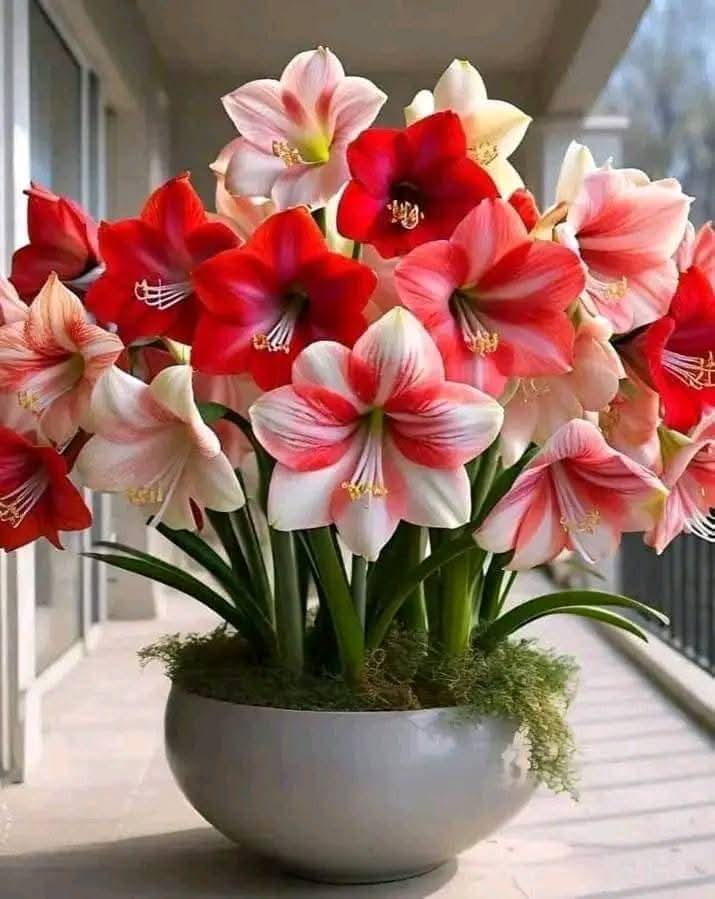Amaryllis (Hippeastrum) is a stunning flowering bulb that produces large, trumpet-shaped blooms, making it a popular choice for indoor gardening and holiday displays. This particular variety is notable for its pristine white petals edged with a delicate red or pink rim, which adds a striking contrast. With the right care, these beautiful flowers can bloom year after year, bringing elegance and color to any space.
If you’re looking to cultivate amaryllis successfully, this guide will walk you through everything you need to know—from planting and watering to dormancy and reblooming.
Why Amaryllis is a Must-Have Flower
Amaryllis is a low-maintenance yet highly rewarding plant, making it ideal for both beginner and experienced gardeners. Here are a few reasons why amaryllis is a must-have:
✔ Spectacular Blooms – Each stem produces multiple large, trumpet-like flowers in vibrant shades of red, white, pink, or even striped varieties.
✔ Winter Blooms – Unlike most plants that bloom in spring or summer, amaryllis can be forced to flower indoors during winter, making it a perfect holiday decoration.
✔ Long-Lasting Flowers – Once in bloom, amaryllis flowers can last 6-8 weeks, providing continuous beauty.
✔ Easy to Grow – With minimal care, amaryllis bulbs can thrive and even rebloom for several years.
How to Grow Amaryllis: Step-by-Step Guide
- Light Requirements
Amaryllis thrives in bright, indirect sunlight. A sunny windowsill is an ideal location, but be sure to avoid direct sun exposure during the hottest part of the day, as this can cause leaf scorch. If growing indoors, rotate the pot occasionally to ensure even light distribution and balanced growth.
- Ideal Temperature
Amaryllis prefers moderate room temperatures:
✔ During growth: Keep the plant in a warm environment of 60-75°F (15-24°C).
✔ After flowering (resting period): Store in a cool, dry place at 50-60°F (10-15°C) for dormancy.
Avoid placing your amaryllis near cold drafts, heaters, or vents, as extreme temperature fluctuations can stress the plant.
- Watering Needs
Initial Planting / After Dormancy: Water very sparingly until you see new growth (a flower stalk or leaves). Overwatering at this stage can cause bulb rot.
During Growth & Flowering: Water when the top inch of soil feels dry. Always use a pot with drainage holes to prevent root rot.
After Flowering: Once the blooms fade, cut the flower stalk near the bulb, but do not remove the leaves. Continue watering and fertilizing to help the bulb store energy for next year’s bloom.
During Dormancy: Stop watering completely when the leaves turn yellow and die back.
- Choosing the Right Soil & Pot
Amaryllis thrives in a well-draining potting mix. A good soil mix includes:
✔ Equal parts potting soil, perlite, and coarse sand or bark chips – this prevents water from pooling around the bulb.
✔ A pot with drainage holes – this helps excess water escape and prevents root rot.
✔ A small pot – Choose a pot that is just 1-2 inches wider than the bulb. Amaryllis likes a snug fit.
When planting, leave the top third of the bulb exposed above the soil line.
Encouraging Amaryllis to Bloom Again
One of the most exciting things about amaryllis is that it can rebloom year after year if properly cared for. Here’s how to ensure a strong blooming cycle:
- Post-Bloom Care
After the flowers fade, cut the flower stalk close to the bulb, leaving the leaves intact.
Keep watering and fertilizing (use a balanced liquid fertilizer every 2-3 weeks).
Place the plant in bright light so the leaves can continue absorbing energy for next season’s bloom.
- Dormancy (Resting Period)
Around late summer or early fall, reduce watering gradually until the leaves naturally turn yellow and die back.
Once all the leaves are gone, stop watering completely and place the bulb in a cool, dark area (50-60°F or 10-15°C) for 6-8 weeks.
After dormancy, repot the bulb with fresh soil and start watering lightly again.
This cycle mimics the plant’s natural growth pattern and encourages it to rebloom in winter.
Common Amaryllis Problems & Solutions
- No Blooms?
✔ Not enough light – Place in a brighter location.
✔ Skipped dormancy – The bulb needs a rest period before reblooming.
✔ Bulb is too young – Some bulbs take 1-2 years to mature before blooming.
- Leaves But No Flowers?
✔ Too much water during dormancy – Let the soil dry completely before restarting growth.
✔ Insufficient nutrients – Use a phosphorus-rich fertilizer to encourage flowering.
- Bulb Rot?
✔ Overwatering – Always let the top inch of soil dry out before watering again.
✔ Poor drainage – Use a well-draining soil mix and a pot with drainage holes.
Fun Facts About Amaryllis
🌸 Amaryllis can grow up to 2 feet tall with multiple blooms on a single stem.
🌸 The plant’s name comes from the Greek word “amarysso,” meaning “to sparkle.”
🌸 Larger bulbs produce more flowers – a high-quality bulb can yield 2-3 flower stalks with 4-6 blooms per stem!
🌸 Some amaryllis varieties are fragrant, making them even more desirable for indoor spaces.
Final Thoughts
Amaryllis (Hippeastrum) is a truly spectacular flowering bulb that brings vibrancy and elegance to indoor gardens. Whether you’re growing them as a holiday decoration or enjoying their blooms throughout the winter, these plants are a rewarding addition to any home.
By providing the right light, temperature, watering, and dormancy care, your amaryllis can continue to bloom year after year, making it a long-term favorite for flower lovers.
So, are you ready to grow your own stunning amaryllis? With the right care, you’ll be rewarded with dazzling blooms that brighten up your space like no other!
More Articles You Might Like
-
Texas Toast Sloppy Joes: The Crunchy, Cheesy Upgrade You Didn’t Know You Needed
There’s something timeless about sloppy joes. For generations, this saucy, savory, and slightly sweet ground beef sandwich has been a go-to comfort food in American kitchens. It’s quick, filling, and family-friendly—perfect for busy weeknights. But what if we told you there’s a way to take this classic dish up a notch? Enter the Texas Toast…
-
Classic Pig Pickin’ Cake
When it comes to Southern desserts, few sweets shine as brightly as the Classic Pig Pickin’ Cake. This nostalgic cake, sometimes called a “Mandarin Orange Cake,” has roots deep in Southern tradition. It gets its playful name from its frequent appearance at pig pickin’s—Southern-style barbecue gatherings where communities come together to enjoy slow-cooked pork, sides,…
-
Lemon Garlic Butter Chicken with Creamy Parmesan Pasta
There’s something irresistible about the combination of tender, golden-browned chicken paired with a creamy pasta coated in Parmesan cheese. Add the brightness of lemon, the depth of garlic, and the richness of butter, and you have a recipe that feels indulgent yet approachable enough for a weeknight dinner. Lemon Garlic Butter Chicken with Creamy Parmesan…



